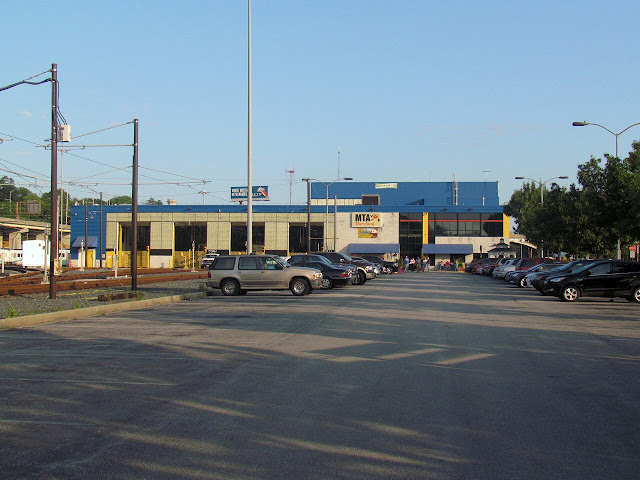Well I am back from my July 4th Weekend break with a really great set of photos. Once again the fact that these photos cover a well attended event exposes me to still being about 9 months behind, but that's a lot better than the 12 month backlog I had built up at its peak so I am making progress!!
Anyway in case you all forgot or missed the plethora of photos posted by more up to date Railfans, last September SEPTA invited a selection of about 200 rail enthusiasts to its annual "Rodeo" and Family Picnic at the Broad Street Subway Fern Rock shoppes. Now I know what you all
were thinking, but the event turned out to be legitimate and it was not just some sting operation to arrest railfans taking pictures on SEPTA Property. The even consisted of three main sections. You had the BSS Fern Rock shoppe floor where many of the assemblies and heavy components of SEPTA transit vehicles were laid out for inspection. You had the BSS rolling maintenance shop where one could walk in and between BSS trainsets as they waited for minor inspections and repairs before being sent back out and then there was the Fern Rock Regional Rail station where examples of every piece of SEPTA rolling stock (except for PP coaches) was on display.
Now this article will be missing one critical part of the show and that is information regarding the original BSS Cam Controllers and the new IGBT replacements. I feel this deserves its own special segment so if you are impatient you can
see it here or just read this first and then view it next.
Anyway you can view the entire set of photos
at this link. SEPTA vehicles will be near the top with Fern Rock interlocking and shoppe photos further down.
http://acm.jhu.edu/~sthurmovik/Railpics/10-09-25_SEPTA_RODEO_2010/-Thumbnails.html
Alright, we'll begin with a sunny show of Fern Rock tower. The tower was made redundant a few years ago when its operations were taken under control by the dispatch office at 1234 Market, but before then it has hosted a US&S style unit level panel machine, which has fortunately been preserved. There is still a local control station available here for contingency plans, but it us normally under remote control.
While the pneumatic switch machines in the Fern Rock yard had been replaced with
electric models
back around 2003, the Fern Rock wye interlocking still retains its
pneumatics, which were recently upgraded with A-10 machines salvaged
from the MFL re-signaling. Here is the #21 switch and you can see the
cover for the previous A-5 machine sitting nearby.
As this was a Saturday, Ridge Line train service was still running.
Here we can see such a train begining its run around the loop track
where one of the direct yard access switched has been removed. Don't
worry, the other direct yard access switch and its
super diamond are still in place.
Here is a video of the same train emerging from the tunnel portal.
Locals were also running and here we see an example as it emerges from the portal and poses in front of the 14LA, 14LC and 12L signals that divide the yard tracks from the signaled Main Tracks. These too date from 2003 when the terminal area was re-signaled. The
original signals were much cooler.
The power operated yard switch machines were changed from
pneumatic DA-10s to electric
YM2000s
back around 2003, but the point indicators remain in their original
1920's housings on high quality concrete bases, although with a
modern LED upgrade.
The Fern Rock shoppes were full of
everything that a BSS car
could ever need.
Here we see a collection of BSS axle sets with their attached
gearboxes, but note the examples with disc brakes that come from some
other vehicle.
As seen with those foreign axles above, Fern Rock is a repair facility
for the entire SEPTA enterprise with things like wheelsets, brake
packages and gearboxes being trucked in from other shoppes for rebuild
and repair. Here we see a truck assembly from an N5 Rt 100 car on
display.
Some of the BSS trucks on display were those still attached to BSS cars, like this one seen on a car-lift. Hmmm, not sure I exactly trust that little wooden chock to keep the car from rolling off there :-/
Here we see one of the M-4 trucks that had to have half of their brakes
removed for the cars to make weight. If you wonder why the system
slowed down after the M-4s were introduced, don't blame the new
signaling system, blame the pathetic friction-only brake performance.
The BSS trucks are wonderfully simple compared to the high tech M-5 and
N-5 examples. Note the use of "package" type tread brakes that were a
step up from older cylinder designs and newer disc designs.
Hmmm, I'll touch that third rail shoe if you touch it first. The
General Steel Castings logo means that most of this truck assembly was
made in America. WOO!!
BSS cars needing heavy repair are rolled into the back of the shop where they can be hooked up to 600V jumper cables.
Moving over to the Rolling Maintenance shop where inspections and light
repairs are carried out we find...AHHHH!! THE DEVIL CAR!! RUN!!























































